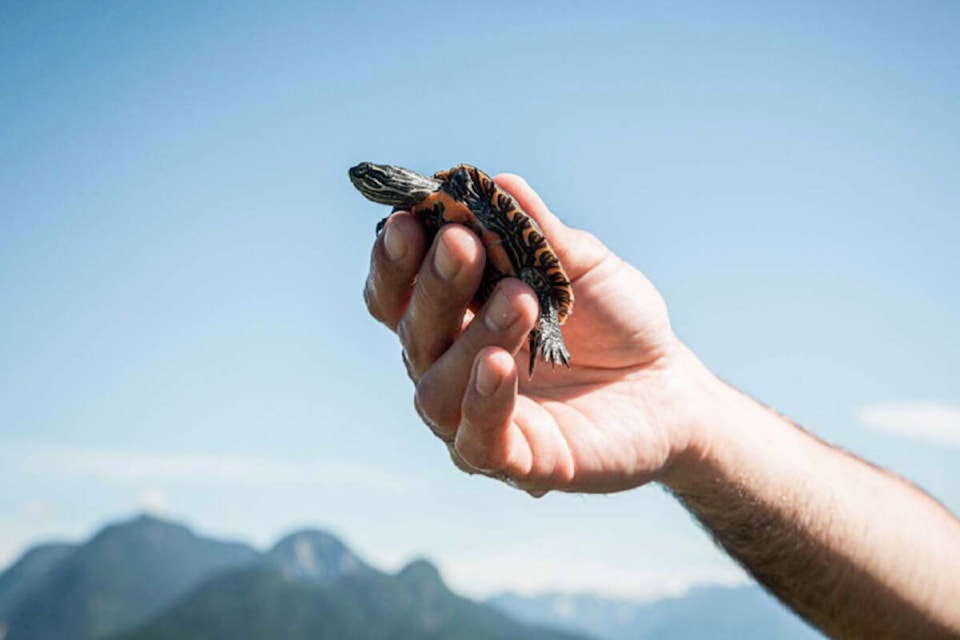By Frank Bucholtz/Special to Aldergrove Star
Greater Vancouver Zoo in Aldergrove is part of an important conservation program that reaches a milestone at this time of year.
The zoo hosts a turtle recovery program, with baby turtles raised from eggs.
It has done so for about a decade, and this year, operators expect about 170 western painted turtles to be released.
They are released at predetermined locations throughout the Fraser Valley, to start new populations, or bolster existing ones, explained biologist Andrea Gielens.
The western painted turtle is the only native turtle species in B.C. and it has been affected by many factors, including human development and activity.
The program at the zoo involves many partners and components. It focuses on the species range along the B.C. coast and on protecting, assessing, and recovering these critical populations.
READ MORE: Zoo donates $31K to endangered wildlife, some in Fraser Valley
Gielens, a wildlife biologist with Wildlife Preservation Canada, which is based in Guelph, Ont., has been part of the program since 2013.
“We are always excited to be able to release the animals we have raised. To be able to release them to the wild to continue to have viable populations is our whole goal, but we do have to let them go and hope that they continue to thrive on their own,” she said.
“The evidence we have collected, doing follow-up surveys, suggests over 95 per cent of the turtles we release will survive. We have even started to see our released animals come back to the beaches to lay eggs. That is what we are looking for, those are our benchmarks for success.”
In 2014, Gielens spoke to the importance of the program in an interview with the Langley Times. She was pleased to be part of the program, because she grew up near the zoo.
That year, the program expected to release 73 juvenile turtles. They were hatched the previous August and spent most of the following year in black plastic tubs inside a small heated barn at the zoo. Their only job was to eat and grow large enough to be released safely into the wild.
Normally, the turtles would hibernate, frozen solid through the winter, but if these creatures had been left to do that, “chances are a lot wouldn’t survive,” Gielens said at that time.
Rather than risk losing more of the already endangered hatchlings, the turtles were brought indoors and kept awake through the winter, being fed spongey cubes of minced seafood, fortified with a calcium supplement. Once a week, they gobbled down a treat of crickets, mealworms, bloodworms and brine shrimp.
Gielens and two colleagues from the zoo shared the duties of caring for their tiny reptilian charges. The project is modeled closely on a successful program that had been going on in the U.S. The results of that program gave Gielens reason to be optimistic.
“They found that released turtles lay eggs and have offspring at the same rate as wild turtles,” she said.
The juveniles are released when they have reached at least 30 grams in weight. Most of them need a full year to reach that weight.
In 2014, the plan was to release the turtles at the same Agassiz farm where the eggs were collected, as well as into the pond at Campbell Valley Regional Park.
There was also a plan that year to affix tiny transmitters to the animals “and follow them around to see what kind of habitat they use.”
In 2013, a dozen eggs were retrieved from a beach on the Sunshine Coast — one that is popular with both people and their dogs — and brought to the zoo.
“If we had left them there (on the beach) to hatch they were unlikely to have survived,” said Gielens. “Someone was going to step on them.”
All 12 of the eggs hatched and were successfully returned to the spot from which they were taken. They were monitored and were doing well, said Gielens.
“Immediately after they were released, they began eating. They knew what they were looking for,” she said in the 2014 interview.
“At one site, we had a bit of a National Geographic moment.”
Near the spot where the juveniles were introduced, there were a number of adults basking. The young turtles swam over to meet the resident adults and they all swam off together.
“It was a real Disney moment,” she laughed.
Unlike a Disney movie, however, there is no guarantee of a happy ending for the Western Painted turtle.
Both the eggs and hatchlings are vulnerable to everything from human activity to animal predation, to vegetation.
That’s why the continued success of the program is so vital to the struggling species.
RELATED: Greater Vancouver Zoo wins award for special program
ALSO: Greater Vancouver Zoo remains dedicated to local and global conservation efforts
.
Have a story tip? Email: roxanne.hooper@langleyadvancetimes.com
Like us on Facebook and follow us on Twitter.
